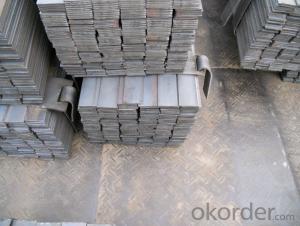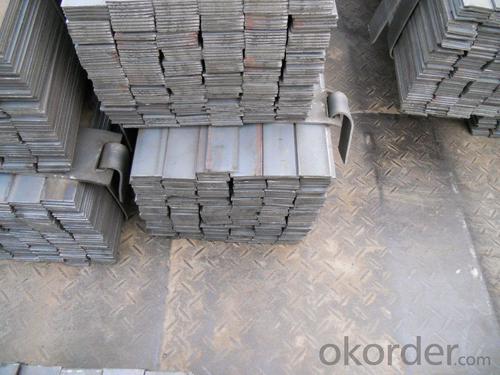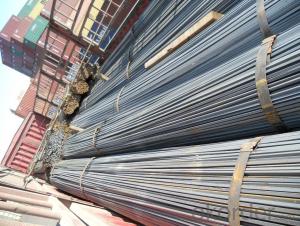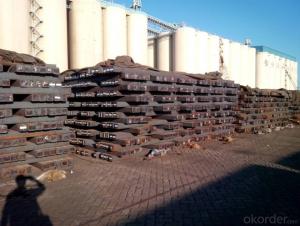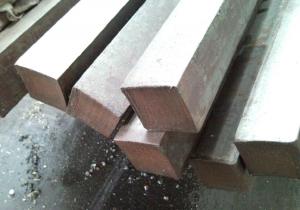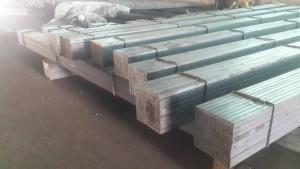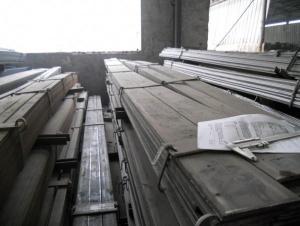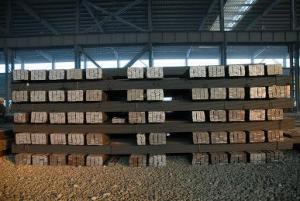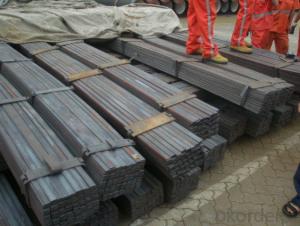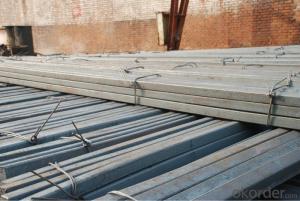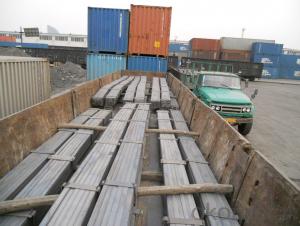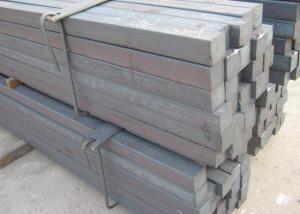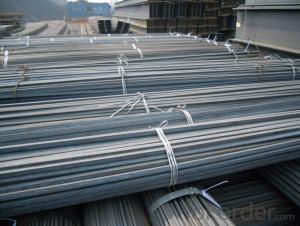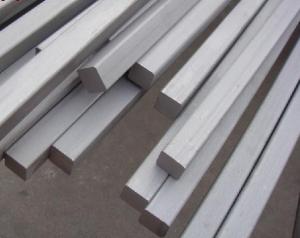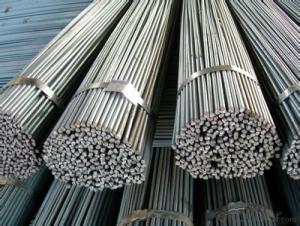Hot Rolled Steel Flat Bars
- Loading Port:
- Tianjin
- Payment Terms:
- TT OR LC
- Min Order Qty:
- -
- Supply Capability:
- 200000 m.t./month
OKorder Service Pledge
OKorder Financial Service
You Might Also Like
Specification of Hot Rolled Steel Flat Bar
Commodity: Hot Rolled Steel Flat Bar
Standard: GB;JIS
Material: Q195-Q235
Brand name: FLATSPACE
Origin place: China
Thickness: 3mm-30mm
Width:20mm-200mm
Length: Max 12m
Certification: SGS/BV
Chemical composition of Q235
Alloy No | Grade | Element(%) | ||||
C | Mn | S | P | Si | ||
Q235 | B | 0.12—0.20 | 0.3—0.7 | ≤0.045 | ≤0.045 | ≤0.3 |
Physical properties of Q235
Alloy No | Grade | Yielding strength point(Mpa) | Tensile strength (Mpa) | Elongation after fracture(%) | ||||||
Thickness (mm) | Thickness (mm) | |||||||||
≤16 | >16--40 | >40--60 | >60--100 | ≤16 | >16--40 | >40--60 | >60--100 | |||
≥ | ≥ | |||||||||
Q235 | B | 235 | 225 | 215 | 205 | 375--500 | 26 | 25 | 24 | 23 |
Usage/Applications of Hot Rolled Steel Flat Bar
Widely used for construction, Machinery manufacturing, Iron tower steel structure, Shipbuilding; Steel grating, Staircase, Bridge, Viaduct, Railway spare parts, Boilers making etc.
Production Flow of Hot Rolled Steel Flat Bar
The steel flat bar is made through three processes:
1.Feeding the material: Feeding the row material (the steel plate) to Slitting Line.
2.Slitting:The steel plate would be slitted into expected width by lengthways cutter.
3. Leveled and cutting: The plat bar would be ground into level by the grinder and then cut into required length.
Packaging & Delivery of Hot Rolled Steel Flat Bar
1.Packaging Details: The Steel Flat Bars are packed in bundles and loaded in 20 feet/40 feet container, or shipped by bulk cargo ,also we can do as customer's requirements.
2.Delivery Details:30~45 days upon the receipt of buyer payment by T.T. or L/C.
3. Marks:
Color marking: There will be color marking on both end of the bundle for the cargo delivered by bulk vessel. That makes it easily to distinguish at the destination port.
Tag mark: there will be tag mark tied up on the bundles. The information usually including supplier logo and name, product name, made in China, shipping marks and other information request by the customer.
If loading by container the marking is not needed, but we will prepare it as customer requests.
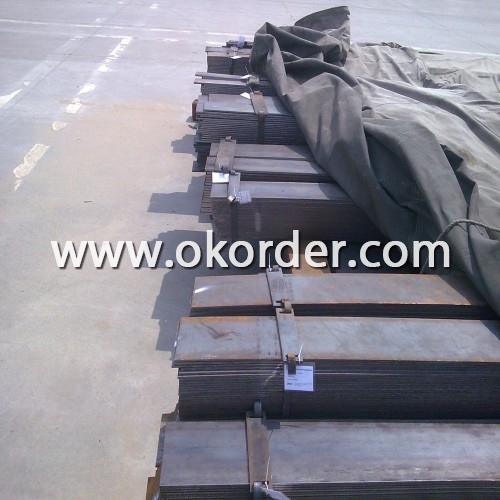
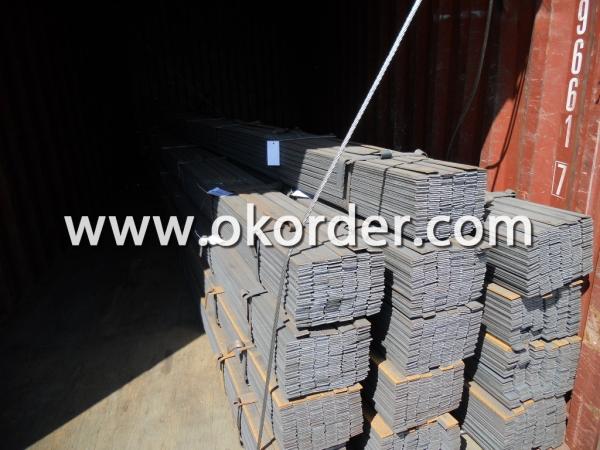
.
- Q: How do you use a steel square to find the height of a retaining wall?
- To use a steel square to find the height of a retaining wall, you would first align one side of the square vertically against the wall. Then, extend the square horizontally until the other side touches the ground at the base of the wall. The measurement on the square where the horizontal side touches the ground indicates the height of the retaining wall.
- Q: How do you use a steel square to create half-lap joints?
- To create half-lap joints using a steel square, first, mark the centerline on both pieces of wood that will be joined. Then, position the steel square on one piece of wood, aligning the centerline with the edge of the square. Use a pencil to mark the width of the half-lap joint on the wood. Repeat this step on the other piece of wood. Next, use a saw to cut along the marked lines, ensuring the cuts are straight and parallel to the edge of the wood. Finally, fit the two pieces of wood together, ensuring the half-lap joints align perfectly, and secure them with glue or screws to complete the joint.
- Q: Can a steel square be used for fence gate installation?
- Fence gate installation can make good use of a steel square. Commonly referred to as a framing square, this versatile tool is widely employed in carpentry and construction projects. Made of steel, it boasts a 90-degree angle and various measurements marked along its edges. When fitting a fence gate, a steel square comes in handy for guaranteeing precise and accurate measurements and angles. It aids in determining whether the gate is properly squared, meaning that all sides are equal, and the corners form 90-degree angles. This is crucial for the gate to function smoothly and fit securely within the fence. Moreover, a steel square can be instrumental in marking and measuring the placement of hinges and other gate hardware. By aligning the square with the gate's edges, one can conveniently mark the desired spots for hinge, latch, and handle installation. In addition, a steel square can serve to check the gate's levelness during installation. By positioning the square vertically against the gate, one can ascertain if it is plumb (perfectly vertical) or if adjustments are required. In essence, a steel square proves to be an invaluable tool for fence gate installation, ensuring precision, accuracy, and proper alignment. It greatly aids in creating a well-constructed and functional gate that enhances the fence's security and aesthetic appeal.
- Q: Can a steel square be used for baseboard installation?
- Baseboard installation can be facilitated using a steel square. A steel square, also referred to as a framing square or a carpenter's square, is a multifunctional tool commonly utilized in woodworking and construction projects. Constructed from durable steel, this tool features a 90-degree angle and a ruler along its edge. The utilization of a steel square can greatly benefit baseboard installation. It aids in achieving precise and accurate cuts on the baseboard material, as well as measuring and marking angles for corners and joints. The 90-degree angle of the steel square is particularly advantageous for marking and cutting baseboards that necessitate perfect fitting into corners or against walls. Moreover, a steel square can be employed to assess the levelness and squareness of the baseboards during the installation process. By placing the square against both the baseboard and the wall, it is effortless to determine if the baseboard is straight and properly aligned. In conclusion, although alternative tools are available for baseboard installation, a steel square is a dependable and versatile choice that can be effectively employed in this task.
- Q: Can a steel square be used for checking the squareness of workbenches?
- Yes, a steel square can be used for checking the squareness of workbenches. A steel square is a woodworking tool that consists of a long, straight edge and a perpendicular arm, forming the shape of an “L”. It is commonly used to determine if an object or surface is perfectly perpendicular or at a 90-degree angle. To check the squareness of a workbench using a steel square, you can place the long edge of the square against the edge of the workbench and align the perpendicular arm with the surface of the bench. By doing this, you can visually inspect if the workbench is square or if it deviates from the 90-degree angle. If the workbench is square, the perpendicular arm of the steel square should align perfectly with the surface of the bench. However, if the workbench is not square, the perpendicular arm will not align perfectly and will indicate that the workbench is not at a 90-degree angle. Using a steel square is a quick and easy way to check the squareness of workbenches and ensure that they are properly aligned for accurate woodworking and other tasks.
- Q: Can a steel square be used for cabinet-making projects?
- Cabinet-making projects can indeed utilize a steel square. This versatile tool, known as a framing square or carpenter's square, is commonly employed in woodworking. Its functionality includes verifying 90-degree angles, measuring straight lines, and ensuring precision in cabinet construction. The steel square is both durable and accurate, serving as a dependable resource for measuring and marking lumber, assessing joint squareness, and confirming cabinet component alignment. Nevertheless, it is worth acknowledging the existence of specialized squares designed explicitly for cabinet-making, such as cabinetmaker's squares or combination squares, which may provide added features or benefits tailored to cabinet-making tasks.
- Q: Can a steel square be used for checking the squareness of a concrete form?
- Yes, a steel square can be used for checking the squareness of a concrete form. The straight edges of the steel square can be aligned with the edges of the form to ensure that they are at right angles to each other. This helps in maintaining the desired square shape of the concrete form.
- Q: What are the markings and graduations on a steel square used for?
- The markings and graduations on a steel square are used for a variety of purposes in carpentry and other related fields. Firstly, the markings are used to measure and mark specific lengths on the material being worked on. The square typically has both imperial and metric measurements, allowing for precise and accurate measurements in either system. These markings help ensure that cuts and joints are made at the correct dimensions, resulting in a more precise and professional finish. Additionally, the graduations on a steel square are used for angle measurements. The square typically has a protractor scale, which allows for the measurement of angles from 0 to 180 degrees. This is particularly useful for tasks such as creating angled cuts or marking out specific angles for joinery work. Furthermore, the square often has additional markings and features that aid in various tasks. For example, it may have a scale for finding the center of a circle or a ruler edge for quick measurements. Some squares also have scribe lines, which can be used to mark parallel lines or reference points. Overall, the markings and graduations on a steel square are essential tools for accurate measurements, angle markings, and various other tasks in carpentry and related fields. They help ensure precision and efficiency, resulting in better quality workmanship.
- Q: How do you use a steel square to mark out 60-degree angles?
- To use a steel square to mark out 60-degree angles, you need to align one of the edges of the square with the line you want to mark the angle on. Then, place a ruler or straight edge along the other edge of the square, making sure it intersects with the line. Finally, draw a line along the ruler or straight edge to mark the 60-degree angle.
- Q: How do you use a steel square to find angles for compound miter cuts?
- To find angles for compound miter cuts using a steel square, the following steps should be followed: 1. Gain a clear understanding of the concept of compound miter cuts, which involve two angles: the bevel angle that determines the saw blade's tilt and the miter angle that determines the horizontal cutting angle. 2. Set the desired tilt for the bevel angle on your saw by either referring to the bevel scale or using a protractor for calculation. 3. Position the steel square against the saw's fence, ensuring that its long edge runs parallel to the fence. 4. Align your workpiece with the edge of the square while placing it against the square. Ensure that the workpiece is flush against the fence. 5. Adjust the miter angle on your saw until the corner of the square aligns with your desired cutting angle. This corner represents the intersection of the bevel and miter angles. 6. Once the miter angle is set, secure it in place on your saw. 7. Validate your setup by making a test cut on a scrap piece of material. Use a protractor or a digital angle finder to measure the resulting angle and ensure accuracy. Remember, compound miter cuts can be intricate, so it is crucial to have a thorough understanding of the specific angles required for your project and make necessary adjustments to your saw. Always prioritize safety by wearing suitable protective gear and exercising caution when operating power tools.
Send your message to us
Hot Rolled Steel Flat Bars
- Loading Port:
- Tianjin
- Payment Terms:
- TT OR LC
- Min Order Qty:
- -
- Supply Capability:
- 200000 m.t./month
OKorder Service Pledge
OKorder Financial Service
Similar products
Hot products
Hot Searches
Related keywords
